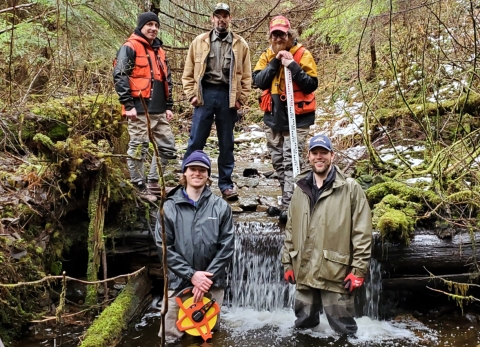Sockeye salmon are the “lifeblood” of Prince of Wales Island, says Quinn Aboudara, who calls the island home. Aboudara is also the Natural Resources coordinator with Shaan Seet Incorporated and the field coordinator for the Klawock Indigenous Stewards Forest Partnership. “The sockeye runs historically have been some of the strongest in the world,” Aboudara says.
The reliable presence of sockeye, Aboudara says, led Indigenous peoples to settle in the Klawock Lake watershed. Thousands of sockeye return to the fresh water of the lake to breed, and the fish continues to be important resource to the community. But the sockeye numbers have been dropping.
“As a child, when I was old enough to start fishing on the beach scene, we could make a single set on sockeye salmon and catch 200 sockeye in a single set,” Aboudara says. “Nowadays, you can go all day and maybe catch 20.”
We are privileged to support many community leaders with 2020’s Klawock Lake Sockeye Salmon Action Plan, which contains a list of restoration projects that will promote healthy and sustainable sockeye salmon populations in Klawock Lake for local communities.
But the work isn’t just about salmon, says Andy Stevens, a fish and wildlife biologist who is the Habitat Restoration Program lead for Southeast Alaska. “Restoring salmon runs is certainly a primary focus of this work as fish are culturally important and a backbone in many of these communities.” But it’s really an “All Hands, All Lands” approach to recovery, he says.
The goals are to “improve wildlife habitat, promote healthy functioning streams and watersheds, increase access to natural products for local communities, and promote local job creation.”
To achieve these “we are working to help increase local capacity to do restoration work and support land co-stewardship,” Stevens says, “by providing training on things like fish passage fish passage
Fish passage is the ability of fish or other aquatic species to move freely throughout their life to find food, reproduce, and complete their natural migration cycles. Millions of barriers to fish passage across the country are fragmenting habitat and leading to species declines. The U.S. Fish and Wildlife Service's National Fish Passage Program is working to reconnect watersheds to benefit both wildlife and people.
Learn more about fish passage , stream, and habitat assessments. We also provide technical assistance, tools and funding to support this work.”
An FY24-25 National Fish Passage project with $4 million in funding from the Bipartisan Infrastructure Law Bipartisan Infrastructure Law
The Bipartisan Infrastructure Law (BIL) is a once-in-a-generation investment in the nation’s infrastructure and economic competitiveness. We were directly appropriated $455 million over five years in BIL funds for programs related to the President’s America the Beautiful initiative.
Learn more about Bipartisan Infrastructure Law will help “continue supporting fish passage restoration, training, and assessment work across the region,” Stevens says. The grantee is Southeast Alaska Watershed Coalition, who has also been a leader in supporting the work of community forest partnerships across Southeast Alaska.
The grant project will restore fish passage to 15.5 miles of high-quality habitat by addressing barriers at Tribal-owned and non-federal lands across Southeast Alaska.
Much of the training and restoration work, especially in the Klawock Lake area, revolve around trees, which may not be what one thinks of when it comes to water-dwelling salmon, but “fish love wood,” Stevens says.
Trees provide nutrients, food, shade, and more. A big tree trunk falling into a stream can provide a pool to rest or shelter in.
Many of the streams of the Klawock area are “over-widened, habitatless areas of stream that’s akin to a bowling alley,” Stevens says.
“Klawock Lake was one of the most heavily logged watersheds on Prince of Wales Island,” Aboudara adds.
“It’s been exciting,” Stevens says, “to see our partners getting out on the ground and documenting new fish passage issues that we are now working on together to address.”
Aboudara talks about the restoration work: “It's just really satisfying to go with the help of a chainsaw and power winches, hand winches, and some good old fashioned hard work. You're pulling these trees and this wood into the stream, and you're making really nice habitat feature at the end of the day.”
The crews Aboudara works with “grew up watching the declines. We watched the forests get cut down. We watched the salmon declining. But that's what really leads our work is we think about the way we grew up. And what we believe is important for us, our connection with to fish, and we want our children, our grandchildren, and their grandchildren. We want this lifestyle to be able to be practiced for the rest of time.”
Stevens says, “It’s been a rewarding experience to be a part of this work and to see the passion that our partners have for ensuring that these natural resources persist into the future for the next generations.”
Working with the Tribal forest partnerships like the Klawock Indigenous Stewards Forest Partnership is one of the primary focuses of our habitat restoration program in Southeast Alaska. Some partners include: Klawock Indigenous Stewards Forest Partnership, Prince of Wales Tribal Conservation District, the Ketchikan Indian Community, Metlakatla Indian Community, Yakutat Tlingit Tribe, Keex Kwáan Community Forest Partnership, Kootznowoo Inc., and Hoonah Native Forest Partnership.









